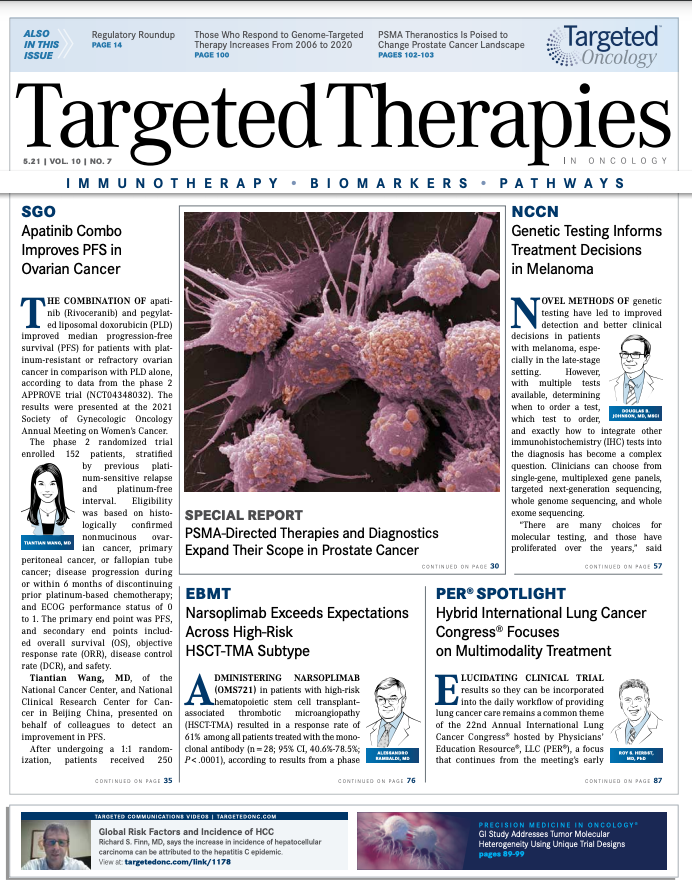Hybrid International Lung Cancer Congress Focuses on Multimodality Treatment
Roy S. Herbst, MD, PhD, discussed the upcoming conference on July 29-31, which will follow a hybrid format with some faculty and attendees participating online and others participating in person.
Roy S. Herbst, MD, PhD

Elucidating clinical trial results so they can be incorporated into the daily workflow of providing lung cancer care remains a common theme of the 22nd Annual International Lung Cancer Congress® hosted by Physicians’ Education Resource®, LLC (PER®), a focus that continues from the meeting’s early days, Roy S. Herbst, MD, PhD, cochair of the conference, said.1 In an interview with Targeted Therapies in Oncology, Herbst discussed the upcoming conference on July 29-31, which will follow a hybrid format with some faculty and attendees participating online and others participating in person.
Like many meetings last year, this conference was held virtually. But because of this year’s hybrid format, “I’m going to get to the conference by hook or by crook,” Herbst said. “I look forward to the meeting every year, and I enjoy the in-person interaction.” In addition to conference cochair, Herbst is the Ensign Professor of Medicine (medical oncology), a professor of pharmacology, chief of medical oncology, and associate cancer center director for translational science at the Yale Cancer Center and Smilow Cancer Hospital in New Haven, Connecticut. Over the course of the 3-day conference, broad topics including early-stage thoracic malignancies, oncogenic fusions, targeting the HER family, novel therapeutic strategies, combined modalities in stage III non–small cell lung cancer (NSCLC), immunotherapy, and molecular testing will serve as guideposts for attendees.
Specific presentations will address ongoing questions from the ADAURA trial (NCT02511106), the multiple therapeutic options available for ROS1-positive NSCLC, enhancing activity of first-line osimertinib (Tagrisso), the use of immunotherapy in early-stage NSCLC, numerous Medical Crossfire® discussions, and appropriate use of liquid biopsies to provide attendees with guidance on these challenging clinical issues (BOX).
“This year’s conference will focus a lot of attention on unique and interesting cases, [and] it will foster and encourage much discussion among the faculty and attendees,” Herbst said, pointing out that the other conference cochairs, David R. Gandara, MD, and Heather A. Wakelee, MD, have been instrumental in developing the cases and panel discussions, ensuring that every discussion provides ample time for questions and answers and a multimodal focus.
Recent Trials
Although not formally included in the agenda, Herbst anticipates a lot of discussion during the conference on the interim results of the IMpower010 study (NCT02486718), which evaluated the safety and efficacy of atezolizumab (Tecentriq) and best supportive care (BSC) in the adjuvant setting of NSCLC.
Investigators reported an improvement in disease-free survival (DFS) compared with BSC when given as adjuvant therapy following surgery and chemotherapy to patients with stage II-IIIA NSCLC.1
In the study, 1005 patients were randomized to receive 16 cycles of atezolizumab intravenously (IV) at 1200 mg every 2 weeks for up to 21 days. Patients received either IV cisplatin 75 mg/m2 on day 1 of up to four 21-day cycles, IV vinorelbine 30 mg/m2 given on days 1 and 8, IV docetaxel 75 mg/m2 administered on day 1, IV gemcitabine 1250 mg/m2 given on days 1 and 8, or IV pemetrexed 500 mg/m2 administered on day 1. The same chemotherapy agents, dosages, and dosing schedules were used in the BSC group.
Looking ahead, the planned analyses of DFS and overall survival in the overall intent-to-treat population of IMpower010 will continue with patient follow-up to retrieve data that were immature at the time of the interim analysis, according to Genentech, the manufacturer of atezolizumab. The safety analysis of trial was completed and showed consistency with the prior known safety profile of atezolizumab.
Herbst said findings from the CheckMate 816 trial (NCT02998528) will also likely be discussed. The randomized, open-label phase 3 study evaluated nivolumab (Opdivo) plus chemotherapy versus chemotherapy alone as neoadjuvant treatment for resectable NSCLC. Patients were randomly assigned to receive either nivolumab plus platinum-doublet chemotherapy (n=179) or chemotherapy alone (n=179), followed by surgery. Pathologic complete response (pCR) was the primary end point.
Findings demonstrated a statistically significant improvement in pCR (odds ratio, 13.94; 99% CI, 3.49-55.75; P<.0001), and benefit was consistent across disease stages, histologies, tumor mutational burden, and PD-L1 expression levels. Investigators reported that the addition of nivolumab to chemotherapy maintained a tolerable safety profile.2
An exploratory subset analysis showed that circulating tumor DNA clearance was more frequent with the combination compared with the monotherapy and appeared to be associated with pCR.2
EGFR Inhibitors
Herbst, who has worked over several decades as a pioneer of personalized medicine and immunotherapy to identify biomarkers and bring novel targeted treatments and immunotherapies to patients, said that he considers his work on the use of EGFR inhibitors his most impactful.
“Improving our understanding of personalized immunotherapy by identifying the right biomarkers continues to be of great importance,” Herbst said. He was coauthor of the phase 2 BATTLE umbrella trial (NCT00409968, NCT00411671, NCT00411632, NCT00410059, NCT00410189), which randomized a total of 255 patients with chemo-refractory NSCLC to erlotinib (Tarceva; n=59), vandetanib (Caprelsa; n=54), erlotinib plus bexarotene (n=37), or sorafenib (Nexavar; n=105) based on molecular biomarkers of NSCLC pathogenesis.
Of these, 244 were eligible for disease control rate (DCR) analysis. Overall, investigators reported a 46% 8-week DCR, a 1.9-month median progression-free survival, a 9-month median overall survival, and a 35% 1-year survival.3
Individual markers predicting a significantly superior DCR for a treatment included EGFR mutation (P = .04) for erlotinib; cyclin D1 positivity (P = .01) or EGFR amplification (P = .006) for erlotinib plus bexarotene; vascular endothelial growth factor receptor 2 positivity (P = .05) for vandetanib; and absence of EGFR mutation (P = .01) or of EGFR high polysomy (P = .05) for sorafenib.3
When comparing the DCRs among the treatment arms, investigators noted a better 8-week DCR for sorafenib versus all other regimens (64% vs 33%; P <.001) in patients with EGFR wild type and versus all other regimens (61% vs 32%; P =.11) among patients with KRAS mutations.
Turning back to the meeting, Herbst said a number of other topics will likely be addressed including: How is immune resistance defined, and what combination of therapies can be employed to address immune resistance? How do you use neoadjuvant therapies based on pCR?
“I think these topics are all important,” Herbst said. “In general, PER® meetings tend to focus on delivering usable information that doctors can take home and apply in the clinic, right away.”
References:
1. Pivotal phase III study shows Genentech’s Tecentriq helped people with early lung cancer live longer without their disease returning. News release. Genentech. March 22, 2021. Accessed April 23, 2021. https:// bit.ly/2OQNxCp
2. Forde PM, Spicer J, Lu S, et al. Nivolumab + platinum-doublet chemotherapy vs chemotherapy as neoadjuvant treatment for resectable (IB-IIIA) non-small cell lung cancer in the phase 3 CheckMate 816 trial. Presented at: American Association for Cancer Research Annual Meeting 2021; April 10-15, 2021; virtual. https://bit.ly/3vdLIPl
3. Kim ES, Herbst RS, Wistuba II, et al. The BATTLE trial: personalizing therapy for lung cancer. Cancer Discov. 2011;1(1):44-53. doi:10.1158/2159- 8274.CD-10-0010

Multiple Resistance Mechanisms Thwart Efficacy for Third-Generation TKIs in NSCLC
April 7th 2024An important clinical strategy that focuses on improved frontline EGFR TKI regimens may help combat acquired EGFR TKI resistance and further streamline treatment options in subsequent lines, according to Balazs Halmos, MD.
Read More
Repotrectinib Elicits an Intracranial Response in ROS1+ Advanced NSCLC
April 5th 2024During a Case-Based Roundtable® event, Christine, Bestvina, MD, discussed the intracranial responses to repotrectinib for patients with ROS1-psotive non–small cell lung cancer in the first article of a 2-part series.
Read More